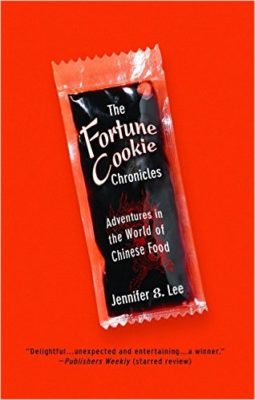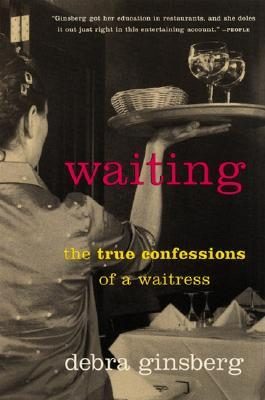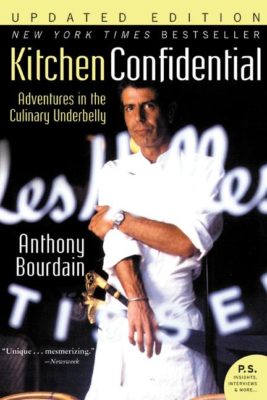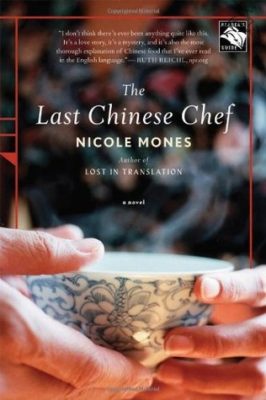Many would assume that by being a chef, I draw the most pleasure out of cooking. That may be true to a certain extent, but I find that I love food so much that I enjoy eating it, writing about it and reading about it just as much as cooking it. I try to find a food related book to read every time I am in a bookstore (which is often!) and I try to read one every other month or as my schedule allows. There are dozens of well-written, food related books that are not cookbooks, and it’s truly difficult to pick just five but here it is. This is my list of my five favorite food literature books.
5. The Fortune Cookie Chronicles: Adventures in the World of Chinese Food
 Author: Jennifer Lee
Author: Jennifer Lee
Why it’s good: Lee endeavors to uncover a mystery regarding how fortune cookies led to numerous people winning the lottery, but ends up discovering more than just that. She uncovers mysteries of the American Chinese food world, including fortune cookies, General Tso’s Chicken and Chopsuey. It’s a definite must read for Chinese food lovers and food trivia hunters.
Get a taste: “Chop suey is the greatest culinary prank that one culture has ever played on another. Even its name is an inside joke of sorts. What Americans believed to be the ‘national dish’ of China translates to ‘odds’ and ‘ends’ in Cantonese. But it was decades before Americans began to realize they had been had. (‘Say, where did they get the chop suey stuff?’ wrote Will Rogers, a California mayor in a letter to the New York Times during his 1932 visit to China – nearly 39 years after chop suey began its explosion into the American landscape. He added, ‘I have run the legs off every rickshaw motorman in China and nobody had ever heard of it.’)”
4. Waiting: The True Confessions of a Waitress
 Author: Debra Ginsberg
Author: Debra Ginsberg
Why it’s good: Ginsberg, a real life working waitress, details some of her (mis) adventures as a waitress, the kind of customers and co workers she has to deal with, the kind of hours she puts in and the money and tips she makes. It is an unabashed view of the restaurant world, this time not from the customer side or the kitchen side, but from the server’s. You get hilarious stories of some of the most difficult or strangest customers and you’ll be astonished that they actually happened in real life. It is a must read if you want to really find out if you should take care in treating your servers right. (yikes!)
Get a taste: “It was with this very intimate understanding of why the customer is always right that we restrained ourselves from cracking wise when a potential customer asked us, ‘How big is a 16 inch pizza?’ or ‘What comes on a cheese slice?’ or even ‘Want me to tell you how you should really make a pizza?’ We said nothing when half of our high school crowd showed up with bags of food from McDonald’s. The other half, after all, were eating pizza. We listened patiently while people gave us decorating tips, menu suggestions, or told us that we should lower our prices.”
3. The Sharper Your Knife, The Less You Cry
 Author: Kathleen Flinn
Author: Kathleen Flinn
Why it’s good: Most food memoirs are written about the tough life chefs go through at work, but very few are as detailed as Flinn is about the tough world that is culinary school. Stories about learning to chop, difficulties handling classmates’ personalities and cooking exams are interesting reads. Flinn also includes some recipes, and of course, some golden nuggets of wisdom that she has picked up over the years. It’s a must read for people considering culinary school and for people who have attended culinary school.
Get a taste: “Culinary school is a messy affair. Every day, new stains and smells assault my whites with vigor. I always wonder who came up with the idea of the standard kitchen uniform. Why white? Le Cordon Bleu uniforms have a deep blue logo emblazoned on the center of the apron and on the left breast of the chef’s jacket. Simply washing them in strong bleach and detergent seems to destroy the blue in the logo yet leave intact the blood, fish guts, veal stock, and other unpleasant residue of our practicals, not to mention a cast of repulsive smells.”
2. Kitchen Confidential: Adventures in the Culinary Underbelly
 Author: Anthony Bourdain
Author: Anthony Bourdain
Why it’s good: What hasn’t been said about Bourdain’s memoir, tell-all book about the previously secret world of the food industry? This book contains the most interesting, honest and entertaining stories about the food world and it is also a passionate, heartfelt message to everyone about the amount of work, passion and dedication that goes into every dish you eat. It is a must read for basically everybody as everyone will find a chapter or two that they will find great interest in.
Get a taste: “At the base of my right forefinger is an inch-and-a-half diagonal callus, yellowish-brown in color, where the heels of all the knives I’ve ever owned have rested, the skin softened by constant immersion in water. It distinguishes me immediately as a cook, as someone who’s been on the job a long time. You can feel it when I shake my hand, just as I feel it on others of my profession. It’s a secret sign, a sort of Masonic handshake without the silliness.”
1. The Last Chinese Chef
 Author: Nicole Mones
Author: Nicole Mones
Why it’s good: The only work of fiction on my list, it is the story of a widowed food writer who sets out to China to handle her late husband’s paternity dispute case. She meets and writes a story of a Chinese American chef who has gone to China to study the Imperial Chinese cuisine that his grandfather was so well known for. Both experiences lead her not only to a greater understanding of Chinese cuisine but also herself as well. The book is equal parts love story, Chinese food history and food porn and the combination makes for an interesting, heartwarming, tummy grumbling read. It is a must read for food and fiction lovers alike.
Get a taste: “She bit into another piece, succulent, soft, perfected. It made her melt with comfort. It put a roof over her head and a patterned warmth around her so that even though all her anguish was still with her it became, for a moment, something she could bear. She closed her eyes in the bliss of relief. She finished and passed out the bones. ‘Are you going to make this for the banquet?’
‘No,’ he said. ‘This I made for you.’
She looked up quickly.
‘These are flavors for you, right now,’ he explained, ‘to benefit you. Ginger and cilantro and chives; they’re very powerful. Very healing.’”